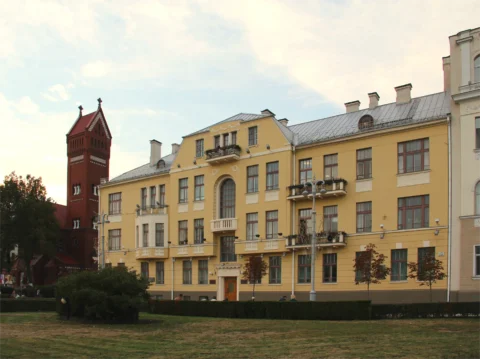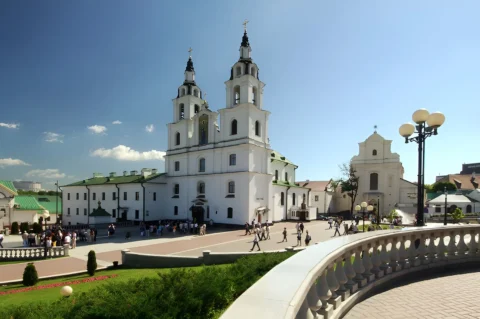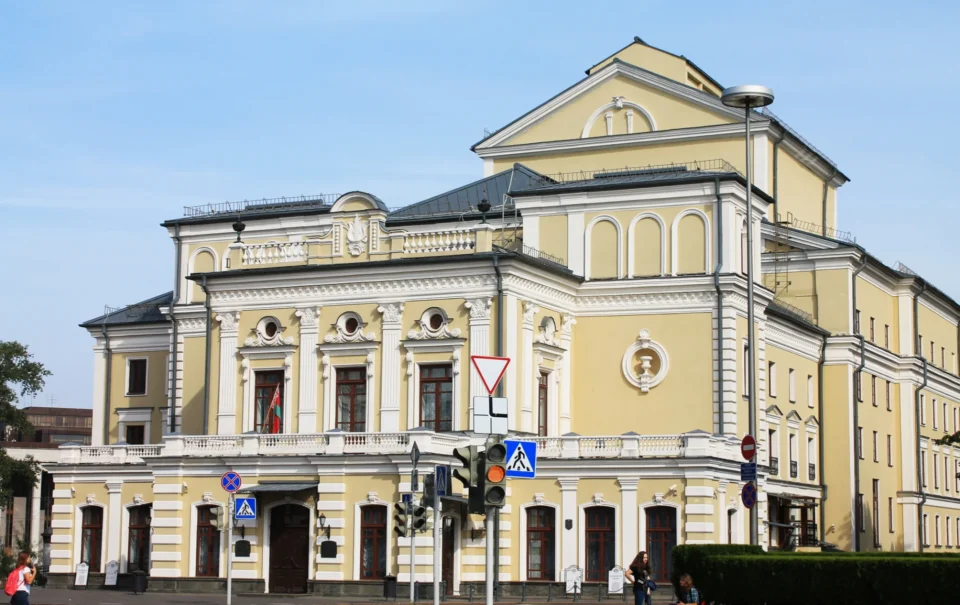
Soviet Architecture Is Part of Minsk’s DNA. It’s austere, monumental, and grand. But more than that, it’s what shaped the face of the city center as we know it today. From the triumphant Gates of the Railway Station to the bold geometry of the National Library, these buildings fuse ideology, ambition, and the vision of architects who once worked on a scale Belarus had never seen before.
If you’re into architecture, history, or just want to see Minsk from a different angle, this route through 7 landmarks of the Soviet era is well worth your time. Some of these buildings have become iconic postcards of the city, others are favorite spots for photo shoots, and a few still spark heated debates about beauty, taste, and the legacy of the past.
The “Gates of Minsk”
Privokzalnaya Square, 1
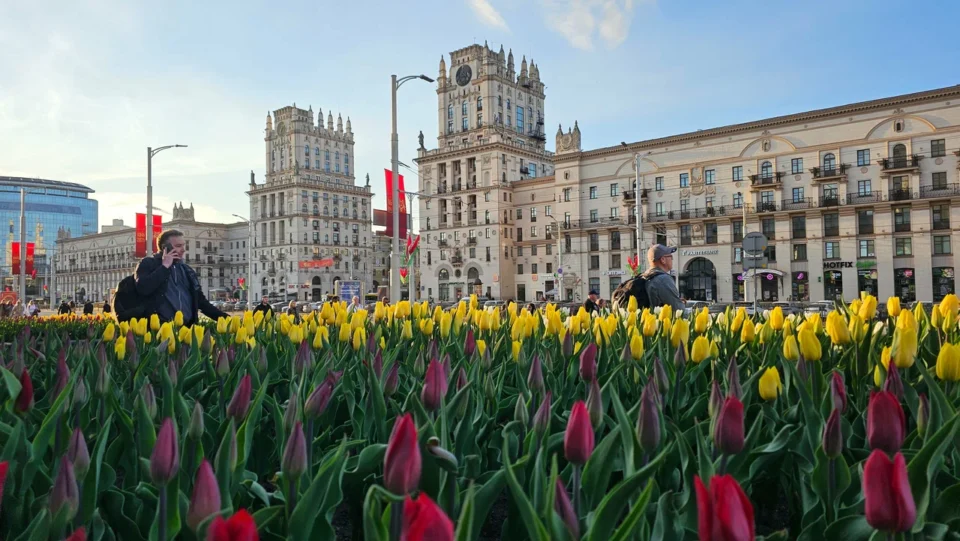
Arguably the most ceremonial welcome a visitor to the capital can receive. These two massive, symmetrical towers – with spires and clocks – greet passengers the moment they step out of the central train station. Built in 1953, the Gates of Minsk quickly became a city symbol: a striking example of Stalinist Empire style, with its flair for theatricality and monumentality.
The project involved architects from Moscow, and the influence of Stalin-era skyscrapers is unmistakable. The towers are adorned with stucco detailing, columns, and heavy sculptural elements. Inside, you’ll find offices and shops, but the real star is the facade itself – unchanged for decades, instantly recognizable on postcards, fridge magnets, and Instagram feeds.
Tip: The Gates look especially impressive at sunrise or in the evening, when the lighting brings out every architectural detail.
The House of Government
Nezavisimosti Square, 1

One of the most recognizable – yet most austere – buildings in the capital. The House of Government is the pure embodiment of pre-war Constructivism: no ornamentation, no stucco flourishes or colonnades. Just clean lines, massive volumes, and restrained geometry. Built in 1934 based on a design by architect Iosif Langbard, one of the key figures in shaping Soviet-era Minsk.
A facade over 100 meters long, perfect symmetry, granite and concrete – everything here is meant to project the strength of the state and the permanence of power. In front of the building stands a statue of Lenin, still on its pedestal despite shifting times. Today, the building houses the Council of Ministers of the Republic of Belarus.
It may not be “photogenic” in the traditional sense, but its scale and ideological clarity leave a lasting impression – especially when viewed from the far side of the square.
KGB Headquarters
Nezavisimosti Avenue, 17

This imposing structure with its columns and pediment is more than just a building – it’s a mood. Few architectural landmarks in Minsk evoke such a conflicting range of associations. Built in the 1950s, the KGB Headquarters is a textbook example of Stalinist Neoclassicism: a strict symmetrical facade, six Corinthian columns, heavy doors, and almost no room for decorative freedom.
Located right in the city center on Nezavisimosti Avenue, it instantly commands attention with its authoritative presence. This building is more than a place of work – it’s an architectural expression of control, order, and discipline, values that were central to the postwar Soviet ideology.
Tip: photographing it up close is not exactly recommended – unofficially, but firmly. So it’s best to admire it from a distance and pass by with a bit of respectful awe.
Victory Monument on Pobedy Square
Pobedy Square
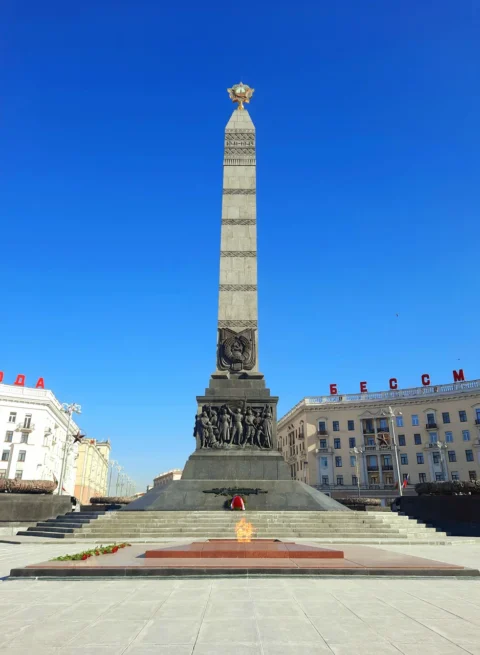
This monument isn’t just an architectural landmark – it’s one of the most meaningful places in Minsk’s historical memory. Unveiled in 1954, it honors the soldiers and partisans who died during the Great Patriotic War. A 38-meter granite obelisk crowned with the Order of Victory rises at the heart of a circular square, where streets converge like rays toward the city’s symbolic core. At its base burns the Eternal Flame.
The monument is designed as a space for silence and reverence. Beneath it lies a memorial hall adorned with mosaics, bas-reliefs, and the names of fallen heroes. Every detail – from the square’s symmetrical layout to the granite facades – serves the purpose of remembrance and dignity. This is not a place for loud entertainment, but one for flowers, reflection, and quiet respect.
Tip: if you’re nearby in the evening, don’t miss the atmospheric lighting and the clean geometry of the square – a perfect example of classic Soviet urban design.
The National Opera and Ballet Theatre of Belarus
Parizhskoy Communy Square, 1
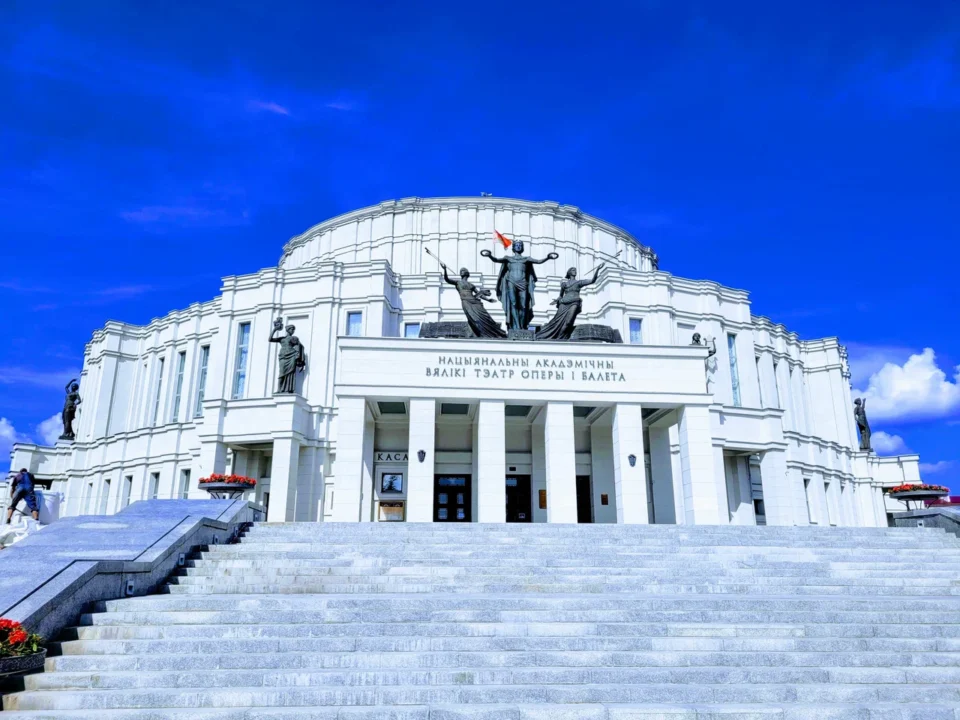
A snow-white building reminiscent of an ancient temple, the theatre is nestled among park greenery and suddenly reveals itself as you approach from Karl Marx Street. Built in 1938 to a design by architect Iosif Langbard, it was one of the first major cultural landmarks of Soviet Minsk – and still stands as one of the city’s architectural gems.
Its style is Soviet neoclassicism with touches of Art Deco. The facade is adorned with sculptures, bas-reliefs, and a grand staircase that leads up to a colonnade. Despite its monumental look, the theatre doesn’t feel heavy – on the contrary, it appears light, almost weightless, especially when bathed in evening light.
Inside: marble, stucco, crystal chandeliers, and elegant balconies. But even if you’re not planning to see a ballet or opera, this building is worth a pause. Look up – and see how Soviet architecture could embody not just authority, but also grace.
October Cinema
Nezavisimosti Avenue, 73

In Soviet times, this was one of the most advanced cinemas in the country – and even today, “October” remains a symbol of how architecture can be both functional and expressive. Opened in the 1950s, the building blends elements of Stalinist Empire style and modernism: restrained décor, symmetry, broad staircases, and a massive portico.
Located right on Independence Avenue, its arched, stuccoed facade is easily visible from the street. Inside, you’ll find renovated screening rooms, modern equipment, and a subtle sense of nostalgia. Festival films, special screenings, and themed evenings are still held here, and for many locals, this place is tied to memories of going to the movies as kids.
Tip: If you step inside, take a moment to look around – the lobby still preserves original Soviet interior details, and that alone makes it worth a visit.
National Library of Belarus
Nezavisimosti Avenue, 116

This giant rhombicuboctahedron is perhaps the most controversial – but definitely the most recognizable – building in Minsk. Its architectural concept was first developed in the late 1980s, during the final years of the USSR, and was envisioned as an “information temple of the future.” The idea only came to life in 2006, but the spirit of Soviet architectural ambition still echoes in every angle.
With 23 floors, millions of books, a geometric crystal-like form, and a massive base, the library looks like a monument to knowledge, culture, and scientific progress. It’s especially striking in the evening, when the façade lights up and turns the building into a slowly shifting mosaic of light.
Inside, you’ll find more than just reading rooms – there’s a book museum, an art gallery, conference halls, a café, and an observation deck with a panoramic view of the city.
Tip: Don’t miss the rooftop terrace – it offers one of the best views of Minsk, and the path to it takes you through an installation dedicated to the history of the written word.
In Place of a Postscript
Soviet architecture in Minsk is more than just concrete and grandeur. It’s a reflection of its time – of the ideas and ambitions of an entire era. From rigid forms and sprawling squares to cultural centers with delicate ornamentation, each building tells a different story of the city, carving it into granite, glass, and metal.
Even if you’re not a fan of Soviet modernism or Stalinist Empire style, these buildings are worth seeing. They help you understand not just Minsk, but the layer of history that shaped its look and feel. And if you look closely, you might find unexpected beauty, drama, and architectural poetry hidden in those heavy facades.
What’s fascinating is that long before these grand Soviet projects transformed the cityscape, Minsk already had its own architectural charm — elegant Art Nouveau buildings from the early 1900s. If the architectural story of the city intrigues you, don’t miss Minsk in Art Nouveau Style: Lesser-Known Masterpieces of the Early 20th Century. These intimate buildings with their flowing ornaments and wrought-iron balconies offer a striking contrast to the monumental scale of the Soviet era.
A walk through Minsk following this route is a journey through time – not dramatic, but deeply respectful of what came before.
